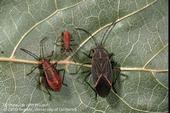- Author: Karey Windbiel-Rojas
![Figure 1. Damage caused by cliff swallows and their nests. [Photo by W. Paul Gorenzel]](https://ucanr.edu/blogs/UCIPMurbanpests/blogfiles/26784small.jpg)
[Article originally appeared in the November 2014 issue of the Retail Nursery & Garden Center IPM News]
Although urban areas are important habitats for migrating birds, birds can also quickly become a nuisance or economic issue when they begin nesting in colonies on buildings and other structures. Their activities can result in disruptive noises, lead to potential structural damage (Figure 1), and their droppings can create aesthetic and human health problems. The most effective method to keep migrating and nesting birds from becoming a nuisance or causing building damage is to exclude them.
Laws...

As temperatures drop and seasonal moisture returns to California, some pests may seek shelter or overwintering sites within homes and other structures. These seasonal nuisance pests (or “occasional invaders”) can cause concern in residents and may lead to unnecessary, ineffective, and potentially harmful pesticide applications, both inside and out. Be prepared to educate your customers about nonchemical exclusion tools, materials, and techniques that can prevent pest entry over the long term, helping to reduce pesticide use around our homes and environment.
Pests invade homes for varying reasons during autumn and winter. Common outdoor species such as
- Author: Cheryl Reynolds

National Hispanic Heritage Month (September 15 – October 15) celebrates the contributions, culture, and history of Hispanic and Latino Americans originating from Spain, Mexico, Puerto Rico, Central America, and South America. These Americans make up the largest minority group in the United States and represent a very important part of the UC Statewide IPM Program's audience.
In recognition of National Hispanic Heritage Month, we'd like to highlight several important resources available from UC IPM to help Spanish-speaking audiences manage pests and apply pesticides safely.
For our Spanish-speaking urban...
![Greedy scale colony. [Photo by J.K. Clark]](https://ucanr.edu/blogs/UCIPMurbanpests/blogfiles/24497small.jpg)
People sometimes don't recognize scales as insects, but understanding scale types and signs of their presence will enable you to best manage them if encountered on your plants.
Scale insects are circular, elongate, or oval insects that often resemble discolored or raised areas on bark, leaves, or fruit. Scales are small and mostly immobile and damage many types of trees and shrubs by sucking out plant juices with their tiny, strawlike mouthparts. Infestations can cause yellowing or premature dropping of leaves, sticky honeydew, and blackish sooty mold. Plant parts can distort or die back, depending on the species and abundance of scales.
Although most plants...
- Author: John A Roncoroni
- Author: Cheryl A. Wilen
![Figure. 1. Some weeds thrive in drought conditions. [Photo by J. Roncoroni]](https://ucanr.edu/blogs/UCIPMurbanpests/blogfiles/24289small.jpg)
[From the August 2014 issue of the Green Bulletin, a newsletter for landscape and structural professionals]
While one of the best methods to reduce weeds is to not water them, there are some that survive even in drought conditions (Fig. 1). As we continue to be impacted by the drought in California, we need to consider our weed management strategies:
- Which weeds will survive?
- How do drought conditions affect control?
Which weeds will survive?
Many weeds, once established, need very little water to survive. Weeds with extensive, deep root...


